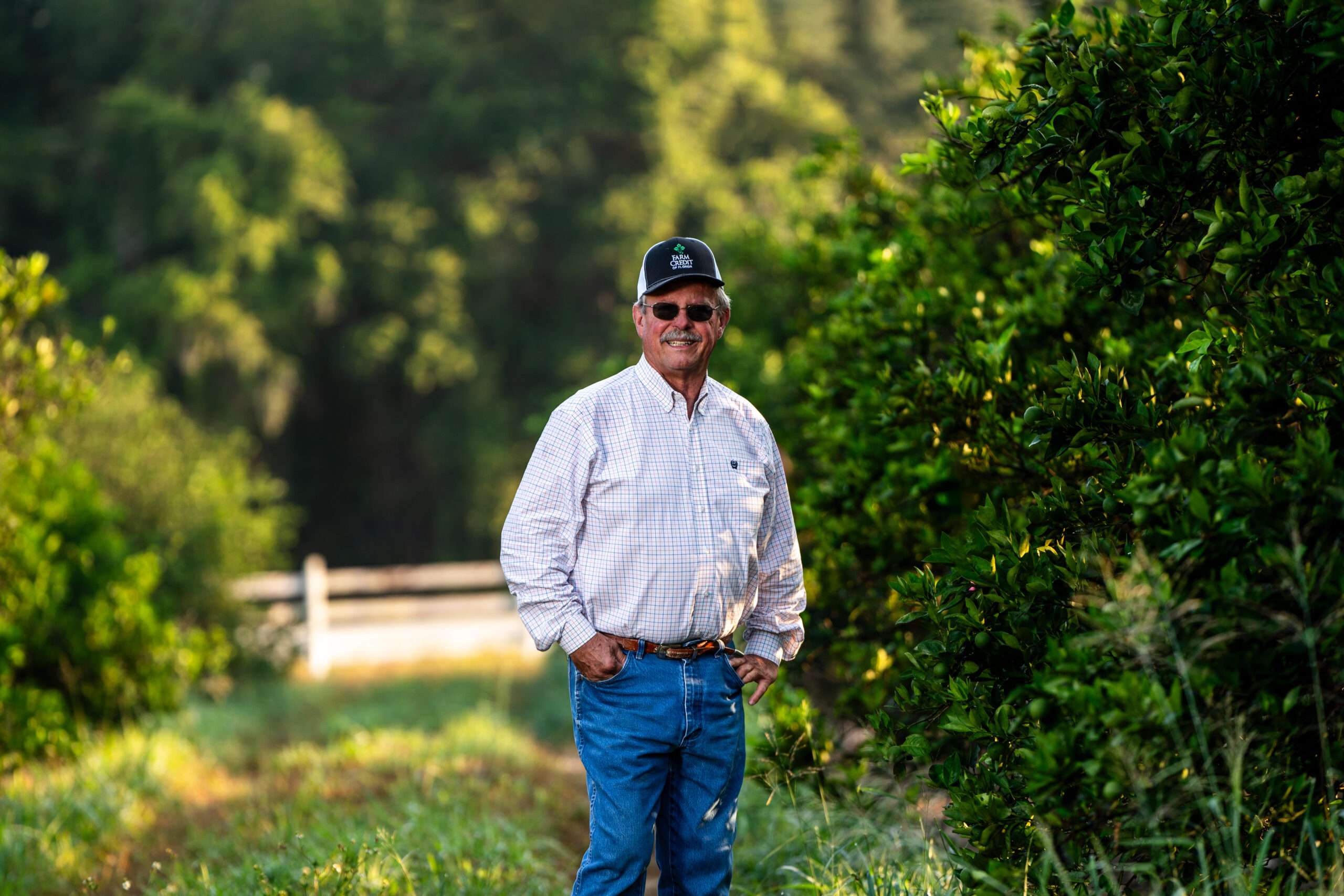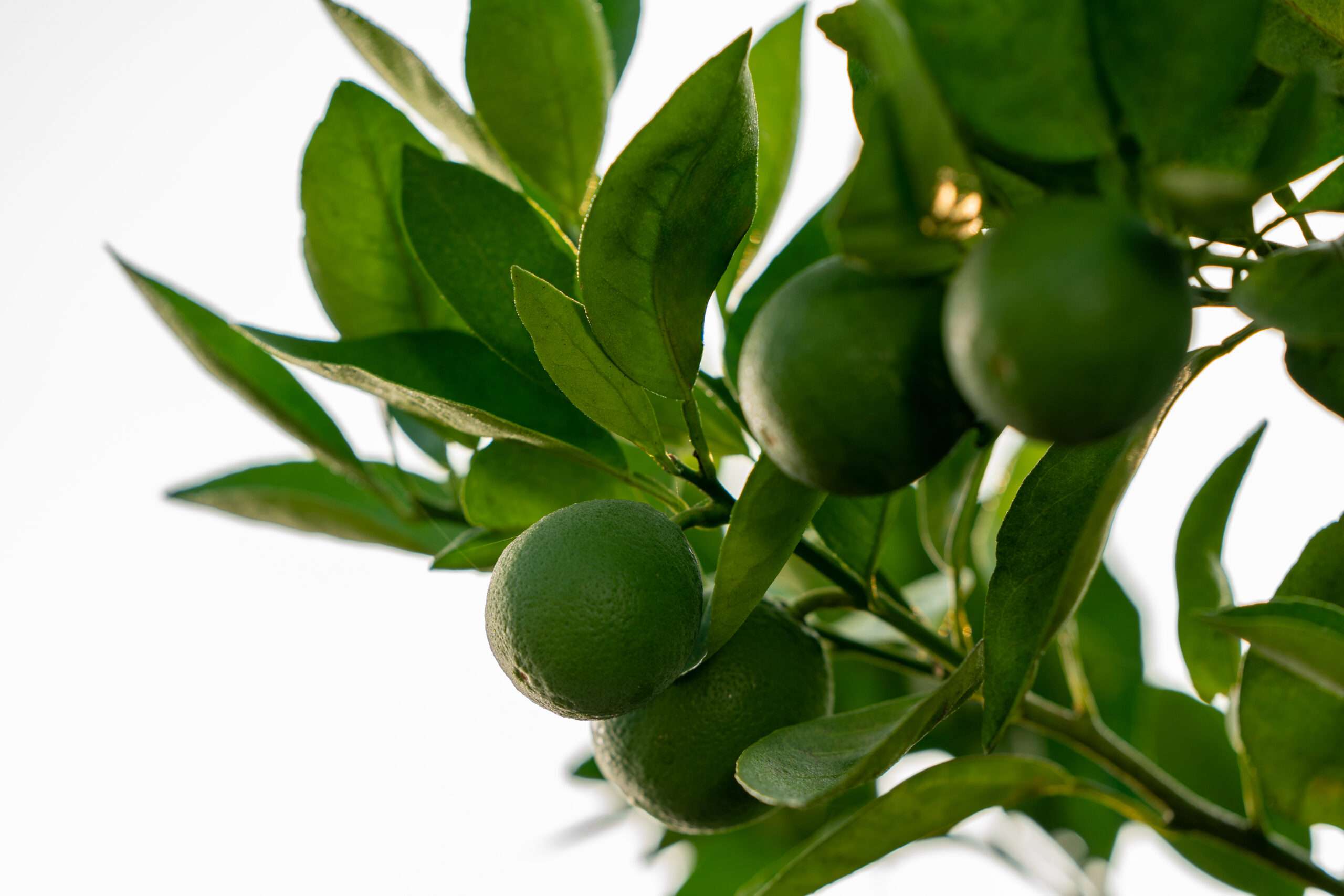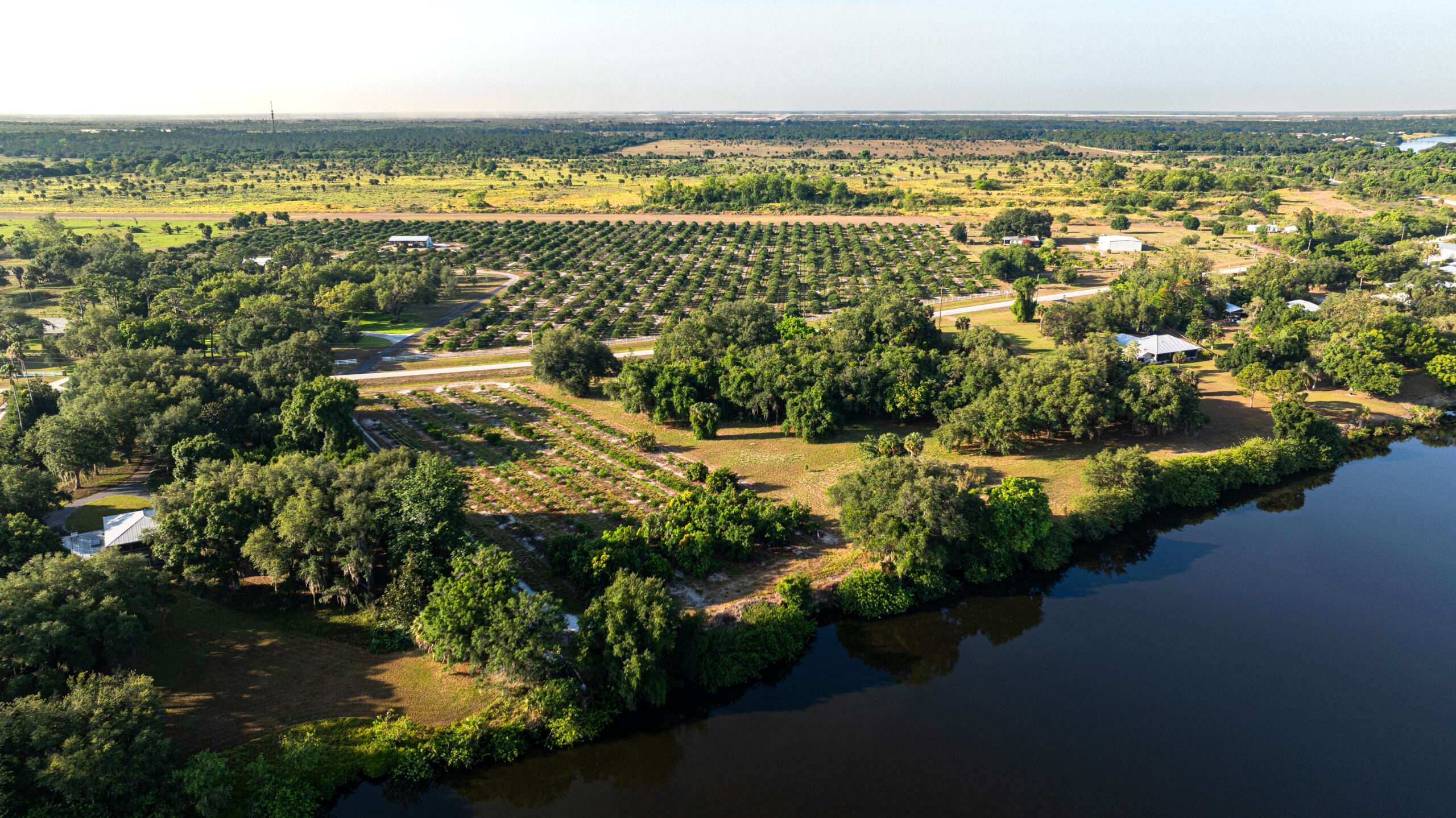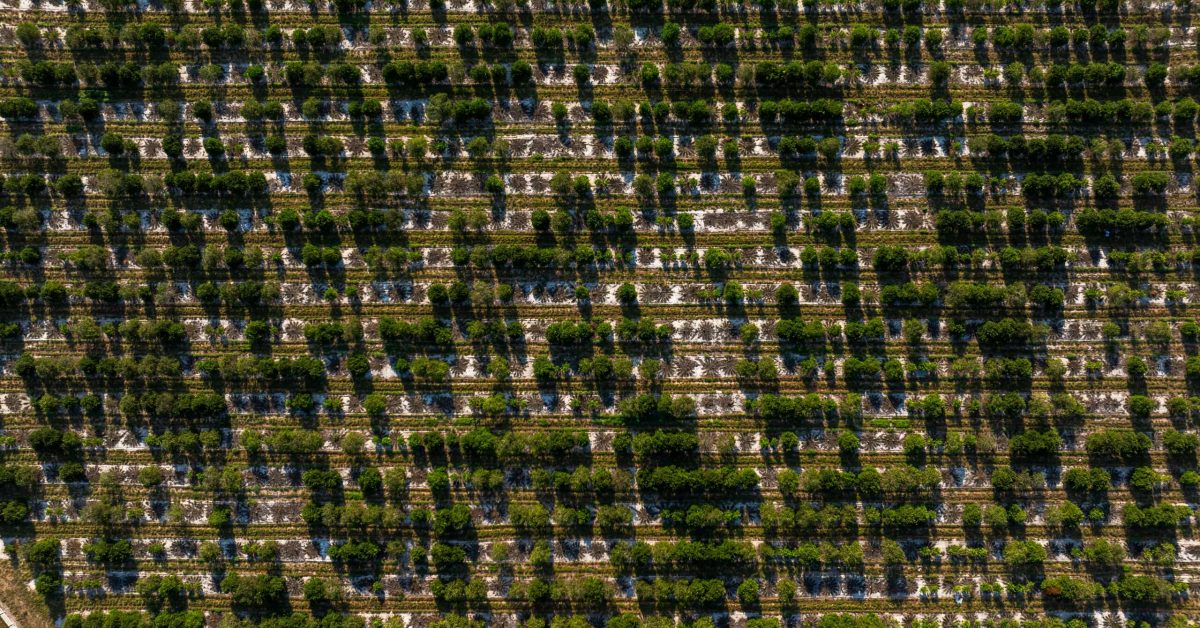End of an Era?
Citrus grower Wayne Simmons stood at the edge of 25 acres planted with early season oranges off Fort Denaud Road, halfway between Fort Myers and Labelle, looking like a man who might be coming to the end of something. Simmons is a fifth-generation Floridian; he’s been in the citrus business all his adult life. He owns the Labelle Fruit Company and was president of the Gulf Citrus Growers Association, a collaborative organization that served Lee, Collier, Charlotte, Hendry and Glades counties. In May, Gulf Citrus closed its doors, bringing an end to a 40-year-old institution and an important advocate for the local citrus industry.
Simmons and I met one afternoon last winter. The sky was high and blue, and the temperature rested around 70 degrees—the kind of day that brings people to the state in droves. It had been a good winter for citrus, Simmons told me. “Good rain,” he said. He pointed to the trees in the grove. “These will probably start blooming in March, ready to start the new crop off.”
The grove we stood in originally was planted in the 1980s. It’s been there for 50 years, but it most likely won’t be there for another 50. In fact, the entire citrus industry might be gone from the state by then. Losses caused by citrus greening and hurricane damage are pushing farmers to sell their land, and former groves are being turned into tract homes and solar fields for the state’s exploding population.
For Simmons and other growers, this would mean the end of a way of life that has defined the agricultural heart of this state for generations. “Our livelihood is in the land,” he told me. “We’re stewards of it. Farming is not a great monetary reward, but it’s certainly the reward of being out in creation.”
We talked about the future of the industry, and I asked what happens if citrus disappears from this state. “It won’t feel like Florida anymore,” Simmons said.
He—like some citrus farmers—has remained stalwart in the face of challenges that continue to assault the industry. “You have to be an optimist or you wouldn’t be farming,” Simmons told me. “We all have to believe that tomorrow is going to be a better day.”
 The Golden Age of Citrus
The Golden Age of Citrus
The citrus industry first came to Florida in the late 1800s, as rumors of astronomical profits created an “orange fever” among land speculators. With the spread of railroads deep into the state, citrus crops could reach wider markets, and the boom escalated. But not for long. In the winter of 1894-95, back-to-back freezes wiped out the majority of citrus trees across the state.
The industry took almost two decades to recover as the groves moved steadily southward toward warmer weather. By the 1920s, citrus growing was back in full swing—according to the Florida Division of Historical Resources, the industry provided most of the jobs in the state of Florida in the early 1920s. But soon disaster struck again: a massive hurricane in 1926 followed by a freeze in 1927 and then another devastating hurricane in 1928. By the time the Mediterranean fruit fly struck the groves in 1929, the state’s citrus industry was already decimated.
Citrus continued to languish during the Great Depression, but the 1940s saw its revival in Florida. World War II created a steady market for citrus growers, and Americans started drinking orange juice with breakfast. Business was back. Between 1945 and 1960, the demand for processed citrus more than doubled. More than 100 million boxes of citrus were picked in 1950, according to the Florida Department of Citrus. By 1970, growers were picking 200 million boxes annually. Growth continued at a steady pace for the next 20 years, though destructive weather always loomed. True to the fears of growers, a record freeze in 1989 wiped out most of the citrus groves north of the I-4 corridor. Lake County, which had been the heart of the citrus industry, went from more than 122,000 acres under cultivation before 1980 to less than 14,000 acres under cultivation by 1990, according to the U.S. Department of Agriculture’s National Agricultural Statistics Service. The industry moved southward once again to the counties of Lee, Collier, Charlotte, Hendry and Glades. The Gulf Citrus Growers Association was born, and citrus growers entered an era of record prosperity.
“The decades of the 1990s and into the early 2000s were the high-water mark of the industry,” says Fritz Roka, director of Florida Gulf Coast University’s Center of Agribusiness and an expert in agriculture economics. “We may look back at it as the Golden Age of citrus. Since then, it’s been a steady march backward.”
First it was citrus canker, Roka said, which struck commercial groves in Southwest Florida in 1998. Then the hurricanes of 2004—Charlie, Frances and Jeanne—followed by Hurricane Wilma in 2005. And on the heels of those storms, the first discovery of citrus greening, a bacterial infection of citrus trees that causes leaf and fruit drop and eventually death. There is currently no cure for citrus greening.
By 2010, greening affected the majority of groves in the state, and citrus production fell steadily to fewer than 18 million boxes in 2021. Between 2001 and 2021, the number of acres under citrus cultivation in the state was cut nearly in half. In the same time frame, production volume dropped by 79%. By the time Hurricane Irma struck in 2017, most groves were already severely weakened from greening. “That was when we saw a precipitous decline,” Roka says. The storm caused roughly $760 million in damages and 30%-70% crop loss, according to the Florida Department of Citrus. Just five years later, Hurricane Ian tore through the middle of the state, causing $247 million in damages to the citrus industry. “Ian in 2022 kind of sealed the deal for the industry,” Roka says.
It’s been almost two years since Ian, and many growers are still struggling to recover. With so many factors challenging citrus production, experts are wondering if the industry will survive.
“Am I saying there’s no hope?” Roka says. “No, I’m not saying that. We’ve got a lot of sharp people in the industry working with equally sharp and dedicated researchers. Until the last tree gets pulled out, there’s always hope.”
 Running Out of Time
Running Out of Time
Growers know there’s no stopping the hurricanes that damage this state. But greening? There might be a fix for that.
In late 2022, TJ BioTech—a South Dakota-based firm focused on developing new technology for the agricultural industry—introduced ReMedium TI, an antibiotic formulation of oxytetracycline hydrochloride, or OTC, injected into the trunk of citrus trees with the aim of suppressing the bacterium that causes greening. Early results from citrus farmers around the state are hopeful, with growers reporting a significant decrease in fruit drop.
The injectable bactericide seems to be a better solution than topically applied bactericides, which have been used in the past. It also is showing itself to be more effective than the CUPS, or citrus under protective screens, method, in which young trees are planted under screens to keep them shielded from the psyllid that transmits greening. This method gives the young trees a chance to establish themselves before they have to begin fighting greening, but it’s costly in terms of both labor and materials.
The greatest hope for the industry lies well in the future, as researchers strive to develop a strain of citrus tree that is greening-resistant. Scientists are currently experimenting with genetic modification, isolating genes from spinach and the mustard family that might lead to a greening-resistant tree. But many growers are doubtful that the solution will arrive in time. Even if a greening-resistant strain of citrus were developed today, groves take years to bear fruit. The first harvest wouldn’t be for another decade, at the earliest. Meanwhile, developers stand ready, cash in hand, to buy up the groves.
 They Don’t Make Any More Florida
They Don’t Make Any More Florida
Simmons told me he understands why so many growers are cashing out and selling their land. Citrus farming is a hard business. “We face challenges every day,” he said. “Diseases and wind and weather and markets—that’s all part of it.” The growers who stay in the business have a little something extra, he believes. “Maybe we’re just more stubborn.”
Though he doesn’t begrudge the growers who call it quits, Simmons is always disappointed when he sees agricultural land go out of production. “One day, it’ll all be gone,” he said. “They don’t make any more Florida.” He looked out over the grove and shook his head. “Then it’s history.”
A Star Is Born
Orange juice didn’t become a staple on the American breakfast table until after World War II, when the process for creating orange juice concentrate was born. In the decade between 1950 and 1960, annual per capita orange juice consumption more than doubled from eight pounds in 1950 to more than 20 pounds in 1960. When a fresher-tasting “not from concentrate” production method debuted in the 1980s, orange juice consumption continued to rise. But in the early aughts, things began to change. American eating habits shifted away from a traditional sit-down breakfast, and as concerns about obesity entered the national spotlight, many people began to cut down on sugar—especially sugary juices including orange juice. Combine these health concerns with the rising cost of OJ, and consumers were suddenly sour on their once-favorite breakfast beverage.
 The State’s Identity
The State’s Identity
“It’s hard for a guy like me, an eighth-generation Floridian who grew up in the citrus industry with millions of orange trees around me, to think there wouldn’t be a citrus industry in the state of Florida. It’s been a staple in our agricultural production and it’s certainly one of those crops we’re identified with. I mean, there’s an orange on our license plates. The litany of terrible things that has happened to the Florida citrus industry is kind of like dying by a thousand cuts, where one thing leads to another, which leads to another. We’ll never get back to where we were—we’ve lost too much acreage—but I think people will always want to eat oranges and drink orange juice. What worries me is that we’ll get to a point where it’s easier to sell the land and plant houses instead of
orange groves.”
— Dean Saunders, founder, managing director and senior adviser at SVN Saunders, a Lakeland-based real estate firm that specializes in conservation easements for rural lands
The Future Is Bright . . . for Some
Florida Power & Light Co. is the largest power provider in the state of Florida and the biggest utility company in the nation, and it has big plans for this state. FPL intends to install 30 million solar panels across Florida by the end of 2025 as part of its goal to eliminate all carbon emissions from its power plants in the next 20 years. The utility company already owns and operates dozens of solar energy centers around the state, including 870 acres in Charlotte County at Babcock Ranch Solar Energy Center. But these energy centers come at a high cost to local farmers, as solar panels are land-intensive, requiring vast acreages to generate sufficient electricity. In a moment when the citrus industry is already flagging, growers are especially vulnerable to offers made by the power company to buy their land.
Abandoned Acreage
Between 2008 and 2016, the United States Department of Agriculture surveyed the number of abandoned citrus acres in the state of Florida. The agency considered a grove abandoned when any of these conditions was met: high weeds and evidence of no tending for production in the previous growing season; the presence of livestock in the groves; trees that had not been pruned or were damaged by weather; trees that showed evidence of pruning after a freeze but no additional tending; the presence of unharvested fruit. In 2016, the latest available data, the agency recorded 130,684 abandoned acres of citrus groves in the state of Florida.
Florida Citrus By the Numbers
The University of Florida’s Institute for Food and Agricultural Sciences report “Economic Contributions of the Florida Citrus Industry, 2020-2021” provides baseline data about the current state of the citrus industry. According to the report, the citrus industry generated $6.9 billion in annual economic contribution to the state of Florida and supported 32,542 jobs across the state. During the period of data collection, the industry produced 57.9 million boxes of citrus fruit and 665 million gallons of juice. But these numbers were pre-Hurricane Ian, noted Marisa Zansler, director of economic and market research at the Florida Department of Citrus. “Florida citrus production has declined by more than 60% since the 2020-21 production season,” Zansler says, “which has negatively impacted growers, juice processors and fresh packers alike. At the same time, the Florida citrus industry continues to provide significant economic contributions to the state and its local communities with a well-established infrastructure situated in key agricultural areas of Florida. Legislative leaders and elected officials continue to support and show a commitment to agriculture and its importance to the state of Florida.”
Evidence of that support: The Florida Legislature’s fiscal year 2024-25 budget earmarked $47 million for the state’s citrus industry, including $18 million for research to combat greening.





